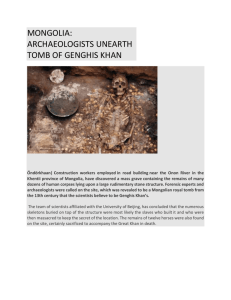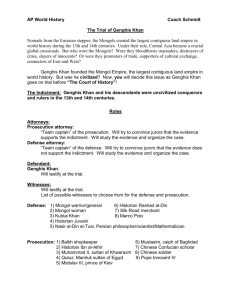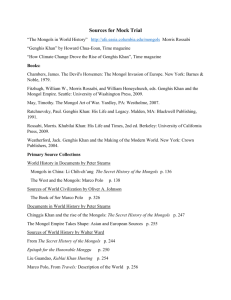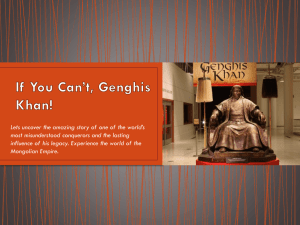Genghis_Khan_WP_020906
advertisement
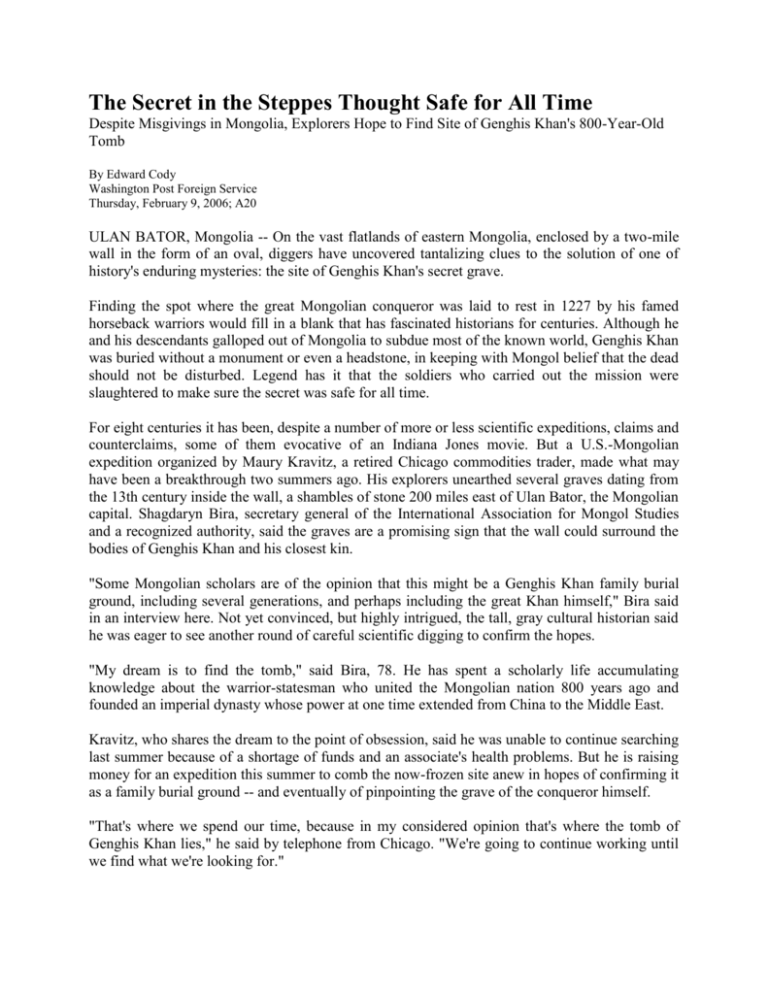
The Secret in the Steppes Thought Safe for All Time Despite Misgivings in Mongolia, Explorers Hope to Find Site of Genghis Khan's 800-Year-Old Tomb By Edward Cody Washington Post Foreign Service Thursday, February 9, 2006; A20 ULAN BATOR, Mongolia -- On the vast flatlands of eastern Mongolia, enclosed by a two-mile wall in the form of an oval, diggers have uncovered tantalizing clues to the solution of one of history's enduring mysteries: the site of Genghis Khan's secret grave. Finding the spot where the great Mongolian conqueror was laid to rest in 1227 by his famed horseback warriors would fill in a blank that has fascinated historians for centuries. Although he and his descendants galloped out of Mongolia to subdue most of the known world, Genghis Khan was buried without a monument or even a headstone, in keeping with Mongol belief that the dead should not be disturbed. Legend has it that the soldiers who carried out the mission were slaughtered to make sure the secret was safe for all time. For eight centuries it has been, despite a number of more or less scientific expeditions, claims and counterclaims, some of them evocative of an Indiana Jones movie. But a U.S.-Mongolian expedition organized by Maury Kravitz, a retired Chicago commodities trader, made what may have been a breakthrough two summers ago. His explorers unearthed several graves dating from the 13th century inside the wall, a shambles of stone 200 miles east of Ulan Bator, the Mongolian capital. Shagdaryn Bira, secretary general of the International Association for Mongol Studies and a recognized authority, said the graves are a promising sign that the wall could surround the bodies of Genghis Khan and his closest kin. "Some Mongolian scholars are of the opinion that this might be a Genghis Khan family burial ground, including several generations, and perhaps including the great Khan himself," Bira said in an interview here. Not yet convinced, but highly intrigued, the tall, gray cultural historian said he was eager to see another round of careful scientific digging to confirm the hopes. "My dream is to find the tomb," said Bira, 78. He has spent a scholarly life accumulating knowledge about the warrior-statesman who united the Mongolian nation 800 years ago and founded an imperial dynasty whose power at one time extended from China to the Middle East. Kravitz, who shares the dream to the point of obsession, said he was unable to continue searching last summer because of a shortage of funds and an associate's health problems. But he is raising money for an expedition this summer to comb the now-frozen site anew in hopes of confirming it as a family burial ground -- and eventually of pinpointing the grave of the conqueror himself. "That's where we spend our time, because in my considered opinion that's where the tomb of Genghis Khan lies," he said by telephone from Chicago. "We're going to continue working until we find what we're looking for." Although Kravitz has been seeking Genghis Khan's tomb for 14 years, the coming dig is likely to generate more than the usual interest here. Mongolians this year have organized a round of horse races and other celebrations to commemorate the 800th anniversary of what they regard as Genghis Khan's first great achievement: unification of Mongolian tribes into a single state. In most of the world, mention of Genghis Khan evokes images of the bloodshed and violence committed by his cavalrymen as they pushed west. When Americans moved against Afghanistan's Taliban in 2001, for instance, Afghan officials compared the invasion to Mongolian attacks in the 13th century and in revenge killed a number of ethnic Hazaras, who descend from those early Mongolian invaders, according to "Genghis Khan and the Making of the Modern World," a 2004 book by Jack Weatherford. Similarly, Iraqi President Saddam Hussein, facing U.S. attack in 2003, drew a comparison between the Americans and the Mongolians who sacked Baghdad in 1258 and executed the caliph. Mongolians have remembered Genghis Khan as the founder of a vast empire who delivered such advances as free-trade zones, census-taking, international postal systems and equality before the law to backward medieval Europeans. The far-reaching Mongol rule of the 13th and 14th centuries was, Bira said, a form of globalization practiced long before the term was invented. Genghis Khan's descendants have enthusiastically embraced this conception of their heritage. Recent governments have sought closer relations with foreign countries after nearly a century as an isolated Soviet satellite. In that vein, the Mongolian Embassy in Washington has raised the idea of erecting a Genghis Khan statue. And here in Ulan Bator, a trendy crowd gathers nightly at the Great Khaan Irish Pub to drink pints of lager imported from Singapore while English soccer plays on big-screen Japanese televisions in a setting patterned on American sports bars. Kravitz, who also has developed an admiration for Genghis Khan's contributions to civilization, said he first became interested in the Mongolian conqueror 45 years ago when a friend gave him a history book to while away the time during service in the U.S. Army in Germany. Although trained as a lawyer and for years busy most of the time on the commodities trading floor, Kravitz said, he read everything he could find on Genghis Khan. In the process, he accumulated a collection of books and documents that he said graduate students still come to consult. But most passionately, he has since 1992 tried to solve the mystery of Genghis Khan's tomb by making nearly annual research expeditions to the Mongolian steppes. The mystery has remained intact over the years in large measure because Mongolians want it that way. Many of the country's 2.8 million inhabitants have clung to the ancient belief that it would be sacrilegious to dig up anyone's tomb, much less Genghis Khan's. In addition, to avoid any nationalist-based opposition, Soviet bureaucrats who ran Mongolia for most of the 20th century closed off the area where the tomb was most likely to be found -- the same area that interests Kravitz today -- fueling the mystique. More recently, a Japanese-organized expedition to find the tomb was closed down after three years in the early 1990s after popular resentment built up on fears that Japanese scientists planned to dig up Genghis Khan's remains if they found them. The Ministry of Education, Culture and Science has instituted regulations requiring a permit for any digs to ensure their legitimacy. But Bira, who has worked with Kravitz, said many Mongolians, officials as well as average citizens, were also uneasy when the Americans began digging. "We had to do a lot of work with people," Bira said. "I told them we were not going to disturb Genghis Khan's tomb," adding that he wanted only to identify the burial location. Bira said the ministry requires evidence of serious purpose before granting the permit, and academic archaeologists have accompanied the expeditions organized by Kravitz. But provincial officials near the site have understood the tourism potential if the walled area does turn out to be Genghis Khan's burial site, he said, and businessmen are already thinking about organizing tours. For many Mongolians, however, there is still something vaguely wrong about digging around in a place that has potentially held its secret for 800 years. Traditional families to this day hold funerals in strict intimacy, sometimes in the hours just before dawn to avoid notice, and many believe disturbing Genghis Khan could bring bad luck. "Oh, you hear these rumors from time to time," said a skeptical Foreign Ministry official, Luuzan Gotovdorjiin, when asked whether the Kravitz dig is on to something. "But I have my doubts. Genghis Khan is Genghis Khan." Researcher Robert Thomason in Washington contributed to this report. © 2006 The Washington Post Company

